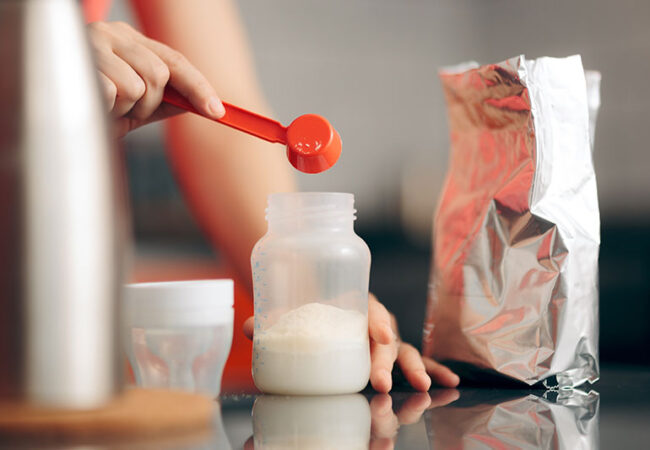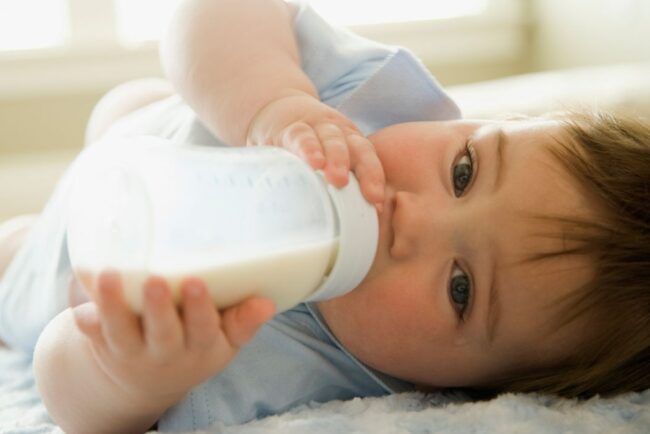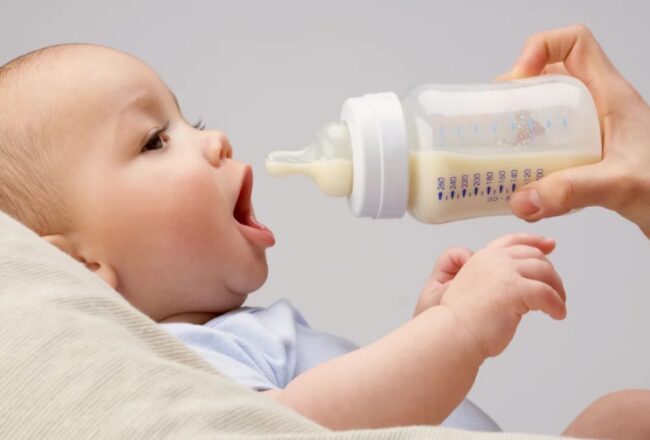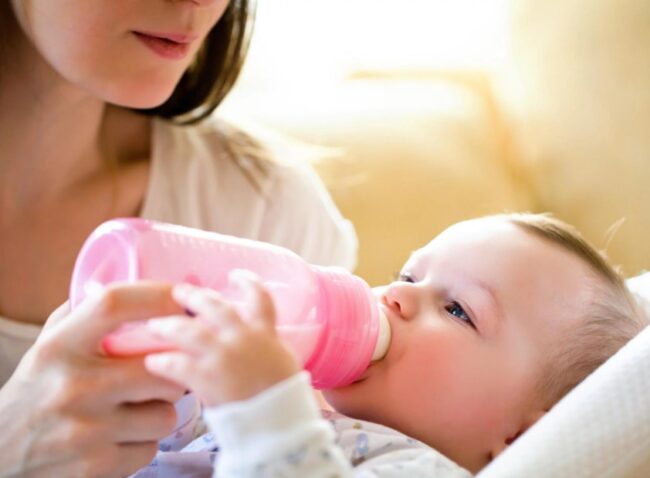If you plan to feed your baby infant formula, you might have several questions. Which brand of infant formula is the best? Are generic brands OK? Is soy-based formula better than animal milk formula? Here’s what you need to know about infant formula.
Forms of Formula

Although breast milk offers newborns all the nutrition they need, not every mom can or chooses to breastfeed. And, moms who breastfeed may find that supplementing with infant formula is a practical alternative if they go back to work or when someone else feeds the baby.
You will find a wide range of brands and types of baby formula available in pharmacies and shops. Always check labels carefully to be sure you’re buying suitable milk for your baby. (Source: BabyBottles)
Commercially prepared infant formula generally comes in 3 different forms:
- Dry powder form
- Liquid concentrate
- Ready-to-feed liquid formula
Powdered Baby Formula

Powdered baby formula is one of the economical and most commonly used baby formulas today. Aside being used as baby formula, it can also be used as breastmilk fortifier for premature and immuno-deficient babies.
Due to it’s dry and powdery nature, little to no bacteria growth activity takes place during storage. Moisture is one of the biggest growth factors for bacteria and germs, thus, cannot thrive in a dry environment.
The powdered baby formula generally lasts longer when opened compared to the other forms of baby formulas, as long as the container is tightly sealed after each use and stored in a cool and dry environment.
However, powdered baby formula isn’t sterile. It may be contaminated with bacteria or germs during storage and/or production which can grow rapidly after being prepared. Powdered formula is the most tedious among all formula forms to prepare.
It must be prepared with filtered water, which means you have to boil the water for no less than a minute and wait for it to cool down to room temperature before mixing in the formula. Or you can choose to use pre-packaged sterile water or distilled water, but this will cost you extra cash.
Nutritionally, the final preparation may be thrown off balance if too little or too much of a component us used. If calculations are not made properly, each feeding may end up being either too much or too little nutritionally concentrated.
This may affect your babies physical and mental development and stress out your baby’s digestive system. Fortunately, most powdered baby formulas come with measuring cups and spoons so that parents and babysitters can get their measurements rights.
Liquid concentrate

This formula form, as it names states, comes in a concentrated liquid form, which should be mixed with filtered or distilled water before use. It is less costly than the ready-to-feed form and less messy to prepare than the powdered formula. Unlike the powdered formula, liquid concentrate is sterile, which means you don’t have to worry about contamination with bacteria and germs.
The concentrated liquid formula is diluted at a 1:1 ratio, so there is little to no chance of calculation errors. Due to its liquid nature, it is intended for short term use. It usually lasts for 24 to 48 hours. Most of the time you might end up throwing some of the formula away because they expired, especially during the early days of your baby’s life where he does not eat much formula, or when you are using formula to supplement breastmilk.
Concentrated formula is generally more costly than dry powdered formula. Aside the cost to buy, you may end up throwing some away, which means extra cost. It is also less convenient since it has to be kept in the refrigerator when not in use. This means you have to warm the bottle to room temperature each time you want to feed your baby.
READY-TO-USE

Ready-to-use baby formula is the most convenient type of formula. It is rich and thick enough, and you don’t need to add any water to it before feeding. It’s less likely to constipate babies than powdered formula is. There’s no measuring, no mixing, no adding of water and no mess. Basically, what you see is what you give.
It’s very convenient and can be carried anywhere. It usually comes in 2-, 4- or 6-ounces containers, so you won’t have to refrigerate any leftovers since your baby is most likely to finish everything in one feeding. Unopened ready-to-feed formula cans can be stored conveniently at room temperature. Once opened, they should be kept in the refrigerator for no more than 48 hours.
While the READY-TO-FEED caption isn’t always prominently displayed on the bottle and can be missed, you’ll definitely not miss the price. Ready-to-feed formula is significantly more expensive than all the other formula forms. If you have easy access to filtered water, and have no problem with calculating formula portions, then you can save the ready-to-eat formula for a rainy day.
Even though the striking price difference is hard to miss, some mothers mistake ready-to-mix formulas for liquid concentrate formulas and dilute them. Ready-to-feed formulas come in already calculated proportions, thus, diluting it will strip your baby off of the nutrients needed for healthy growth. So be sure to read the label well before using any baby formula.
A growing awareness of the health risks of Bisphenol A (BPA) has turned attention to ready-to-feed formulas. BPA is a chemical used in lining plastic food and liquid containers such as baby bottles. BPA is said to cause neurological, reproductive and cardiovascular problems in a long run.
Fortunately, most baby formula brands have turned away from using BPA. These brands usually indicate it on the packaging. Be sure to check before purchasing any ready-to-eat formulas or any other baby food contained in a plastic bottle. You can find BPA free read-to-feed formulas at organicsbestshop.com
In general, whether it is powdered, liquid concentrate or ready-to-eat baby formula, each comes with its own pros and cons. Each formula is safe as long it is stored in a clean and cool environment. Powdered formula is less costly and you’re less likely to throw away than the liquid versions. But if you’re willing to spend a few coins for more convenience and less labour, then there’s no problem getting the liquid ones.
